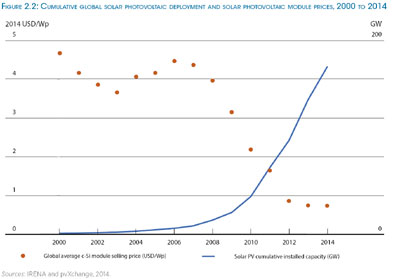Renewable energy costs the same or less than fossil fuels in most US states and in many parts of the world – very impressive for such a young industry.
42 of 50 Cities in US
In the US, solar is the more economical choice in 42 of the 50 largest cities, according to Going Solar in America, by the North Carolina Clean Energy Technology Center. Even fully financing a solar system (at 5% interest) costs homeowners less over its life than buying electricity from the local utility.
Because of high electricity prices, installing solar is cheapest in NYC and Boston, followed by:
Albuquerque, NM
San Jose, CA
Las Vegas, NV
Washington DC
Los Angeles, CA
San Diego, CA
Oakland, CA
San Francisco
But even people in states with moderate utility rates like North Carolina benefit because mid-Atlantic and southern states have the lowest installation costs.
Americans should no longer consider buying a solar system as a luxury, they say, but it does depend on the amount of sun and policies like the 30% federal tax credit and net-metering in the states. Over the 25 years of the solar systems people buy today, utilities are expected to increase electric rates 83%.
If the federal Investment Tax Credit stays in place, solar will cost the same or less than utility prices in 47 states by 2016, according to Deutsche Bank. If Congress allows it to fall to 10%, solar will have price parity in 36 states.
Importantly, solar costs would drop a lot more if more people understood what a great deal it is. That’s because up to 64% of the cost is now "soft" customer acquisition costs, says the North Carolina Clean Energy Technology Center.
Read our article, Solar Has Another ‘Best Year Ever’ in 2014.
Home Buyers Pay More for Solar
Home buyers consistently pay about $15,000 more for homes with solar – a typical 3.6 kilowatt PV system – showing that it is increasingly viewed as a key asset that maintains home value in addition to lowering electricity costs.
Researchers at Lawrence Berkley Lab led a team that analyzed 22,000 home sales in eight states from 2002-2013 – 4,000 of which have solar. Homes ranged in price from $200,000-$900,000.
Solar gives a home "green cachet" they conclude, because the price premium doesn’t vary much based on the size of the solar system. Newer solar systems get double the premium than those eight years or older.
The major point is "if you install solar and then sell your house, you should be able to get a significant portion of your money back. That’s something we couldn’t say with as much confidence before," says Ben Hoen, lead researcher. New home builders should take notice as well as those that are considering selling their house in the near term. Also, the real estate industry needs to include this when they appraise homes.
Renewables Worldwide
Onshore wind, geothermal, biomass and hydropower cost the same or less than coal, oil and gas-fired power stations, even without financial support and despite falling oil prices, says IRENA in Renewable Power Generation Costs in 2014. Solar PV leads the cost decline – modules cost 75% less since the end of 2009 and 50% less for utility-scale solar PV since 2010.
This chart shows the growth of solar as prices come down, 2000-2014

- Onshore wind consistently provides electricity at $0.05 per kilowatt-hour (kWh) without subsidies in Europe and elsewhere, compared to $0.045 to 0.14/kWh for fossil fuel power plants.
- Wind energy costs $0.06/kWh in Asia, $0.07 in North America and $0.09 in Africa.
- Residential solar PV systems cost some 70% less than in 2008
- Total costs for utility-scale solar PV dropped 65% since 2010, with the most competitive projects delivering electricity for $0.08/kWh without subsidies.
- When damage to human health from fossil fuels is factored in, along with the cost of carbon emissions, the price of fossil fuel-fired power generation rises to $0.07-$0.19/kWh.
These costs, however, vary widely based on resources and availability of financing.
"Now is the time for a step-change in deployment for renewables," says Adnan Amin, Director-General of IRENA. "It has never been cheaper to avoid dangerous climate change, create jobs, reduce fuel import bills and future-proof our energy system with renewables. This requires public acknowledgement of the low price of renewables, an end to subsidies for fossil fuels, and regulations and infrastructure to support the global energy transition."
Read our article, Global Solar Hits Parity Next Year, No Subsidies Needed.
